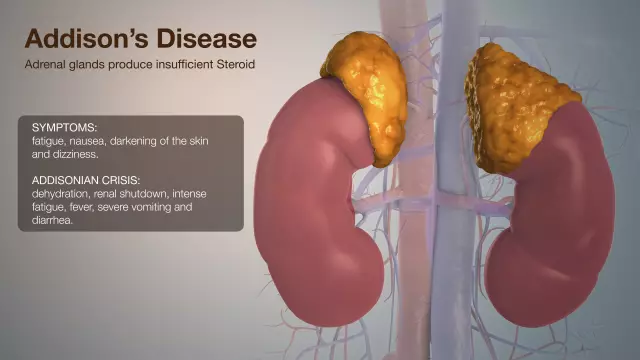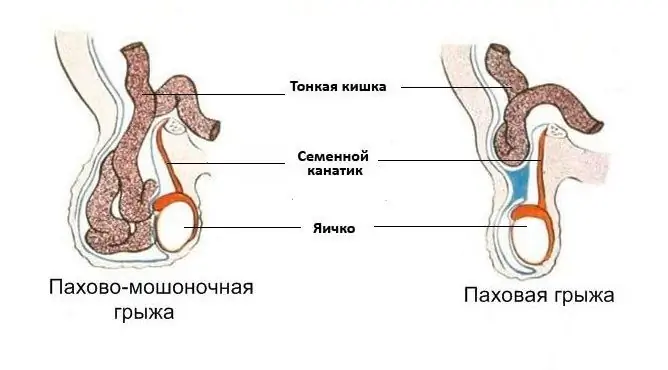- Author Rachel Wainwright [email protected].
- Public 2024-01-15 19:51.
- Last modified 2025-11-02 20:14.
Femoral hernia
The content of the article:
- How is formed
- Reasons for the formation
- Kinds
- Clinical manifestations
- Complications
-
Diagnostics
Differential diagnosis
- Treatment
- Video
The exit of the abdominal organs (intestinal loops, omentum) beyond its limits through the femoral canal is called a femoral hernia. Pathology is more common in women, in many cases it is asymptomatic. Complaints arise with the development of complications, the most common of which is infringement, and hernias of this localization are prone to infringement. Diagnosis is based on data from anamnesis, examination, ultrasound examination. Therapeutic tactics when a disease is detected is operational.

Femoral hernias are formed due to weakness of the abdominal wall against the background of increased intra-abdominal pressure
How is formed
Between the inguinal ligament and the pelvic bones is a space called the femoral triangle. It, in turn, is divided into two parts - muscle and vascular. The first contains the iliopsoas muscle and the femoral nerve, the second contains the femoral artery and vein. The vascular part, or lacuna, is the main site of the formation of pathology.
Normally, the vascular lacuna does not have free spaces and cracks, but under certain conditions, through its inner part - the femoral ring, under the skin of the anterior surface of the thigh, an intestinal loop or omentum goes out together with the peritoneum, forming the femoral canal. It is located almost vertically and has a length within three centimeters. The oval fossa, located on the wide fascia of the thigh, is its outer opening.
Reasons for the formation
Imbalance between pressure in the abdominal cavity and the ability of the abdominal walls to resist it is the main reason for the development of hernial protrusion in the femoral triangle. This equilibrium is disturbed in many conditions.
| Cause | Predisposing factors |
| High intra-abdominal pressure | Severe obesity, muscle tension of the anterior abdominal wall during hard physical labor, lifting significant loads, sharp bends, chronic constipation, severe flatulence, ascites, large tumors and abdominal trauma, severe and prolonged cough, indomitable vomiting, pregnancy, prolonged labor. |
| Weakening of the abdominal wall | Age-related processes that reduce the elasticity of connective tissue structures, rapid weight loss, exhaustion, trauma and violation of the innervation of the abdominal wall, cicatricial changes, numerous pregnancies, a hereditary feature. |
Kinds
The classification of hernial protrusions in the thigh area is carried out according to various criteria.
| The characteristic underlying the classification | Variety |
|
Localization |
Typical: Exits through the femoral canal between the femoral vein and the lacunar ligament. |
| Atypical: muscular-lacunar, lateral vascular (extends outward from the femoral artery), prevascular (comes out in the region of the vessels or is located directly above them), lacunar (passes through the lacunar ligament). | |
| Formation stage | Initial: does not extend beyond the inner femoral ring. |
| Incomplete, or canal: located inside the canal, within the superficial fascia. | |
| Complete: leaves the canal into the subcutaneous tissue of the anterior surface of the thigh, rarely - into the labia in women, in the scrotum in men. | |
| Clinical manifestations | Recoverable: the contents of the hernial sac easily return to the abdominal cavity. |
| Irreducible: the contents of the hernial sac can only partially be returned to the abdominal cavity or cannot be reduced at all. | |
| Restrained: the hernial contents are compressed in the hernial orifice, this leads to impaired blood supply and tissue necrosis. |
Clinical manifestations
In the initial stage, the hernia is often asymptomatic. In an incomplete stage, it can manifest itself as discomfort in the groin area or in the lower abdomen on the affected side. Unpleasant sensations usually increase with different physical activity.
A characteristic symptom of a complete hernia is a pathological tumor-like protrusion in the medial part of the upper third of the thigh, just below the inguinal ligament. Appearing in an upright position of the body and when straining, the formation can easily be adjusted into the abdominal cavity.
With the development of complications, the clinic depends on the contents of the hernial sac. If the bowel loop is impaired, and this is the most common option, then appear:
- tension and soreness of the hernial protrusion;
- sharp local or diffuse abdominal pain;
- restless behavior;
- pallor of the skin;
- weakness;
- nausea;
- repeated vomiting;
- stool and gas retention.
Complications
In the absence of treatment, phlegmon (purulent fusion) of the hernial sac may form: edema, redness of the skin, severe soreness, fever, increased intoxication. Involvement in the pathological process of the peritoneum, perforation (violation of the integrity) of the stretched part of the restrained intestine lead to the development of peritonitis (inflammatory lesion of the peritoneum). This condition threatens the patient's life and requires urgent surgical intervention.
Diagnostics
At the initial stage of formation, the diagnosis of a hernia of the described localization presents certain difficulties due to the practical absence of complaints. When recognizing pathology, attention is paid to the formation of small sizes in the area of the femoral-inguinal fold, which appears in an upright position. The survey and examination of the patient is complemented by an ultrasound examination, if necessary, with a photo printout.
Differential diagnosis
Differential diagnosis is carried out with diseases that have similar symptoms.
| Pathology | Characteristics |
| Inguinal hernia | It is located above the inguinal ligament, when feeling the superficial inguinal ring with a finger, a positive symptom of a cough push is determined. |
| Lipoma | It has a lobular structure, which can be determined by feeling, is not connected with the external opening of the femoral canal. |
| Lymphadenitis - an inflammatory lesion of the lymph node | It is combined with inflammatory processes of the groin area, genitals. When grasping the lymph node with the fingers and pulling it outwards, it is possible to establish the lack of communication with the canal. |
| Varicose node of the great saphenous vein at the confluence of the femoral vein | Usually combined with varicose veins of the thigh and lower leg. It easily collapses when pressed with a finger and quickly returns to its original shape after it is removed. Thinning and bluish discoloration of the skin over the node, no symptom of cough impulse are characteristic. |
| Tuberculous abscess (delimited accumulation of pus) | Appears with tuberculous lesions of the lumbar spine. When pressed, it decreases in size, but there is no symptom of a cough shock, fluctuation is determined. Painful points are revealed in the area of the spinous processes of the affected vertebrae. |
Treatment
Conservative tactics are not used. If pathology is detected, surgical intervention is indicated - hernioplasty (elimination of a hernial protrusion with plastic defect). The operation presents certain difficulties, which are due to:
- narrow lumen of the femoral canal;
- the close location of the vein;
- atypical in many cases, the location of the obturator artery.

Femoral hernias are subject to surgical treatment
When performing the operation, the surgeon needs to excise the hernial sac as high as possible in order to eliminate the so-called peritoneal funnel, and then sew up the hernial orifice. Surgical methods are divided into two groups depending on the access to the hernial orifice.
| Way | Characteristic | Operation modification |
| Straight (femoral) | The approach to the femoral canal is carried out from the side of its inner opening | Operation Bassini: incision parallel to or below the inguinal ligament over the protrusion, isolation and high excision of the hernial sac, suturing the inguinal ligament to the pubic bone periosteum, without squeezing the vessels, 2-3 sutures. |
| Indirect (inguinal) | The approach to the hernial sac is carried out through the inguinal canal | Operation Ruji - Parlavecchio: opening of the inguinal canal and dissection of the transverse fascia, isolation of the hernial sac, excision, sutures between the inguinal and superior pubic ligaments, stitching of the oblique and transverse abdominal muscles together with the transverse fascia to the ligaments. Strengthening the anterior wall of the inguinal canal due to the aponeurosis of the external oblique abdominal muscle. |
The incidence of postoperative relapse is high. Therefore, either the laparoscopic technique or prosthetics of the femoral canal without tension of the stitched tissues using allomaterial, a synthetic material capable of implantation into the tissues of the body, is now widely used. For this purpose, special polymer meshes are used.
In case of infringement of the hernial protrusion and the development of complications, it is necessary to resort to intra-abdominal surgical access. A midline laparotomy (incision of the anterior abdominal wall) with resection of a non-viable section of the intestine is performed.
Video
We offer for viewing a video on the topic of the article.

Anna Kozlova Medical journalist About the author
Education: Rostov State Medical University, specialty "General Medicine".
The information is generalized and provided for informational purposes only. At the first sign of illness, see your doctor. Self-medication is hazardous to health!






